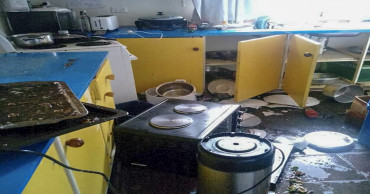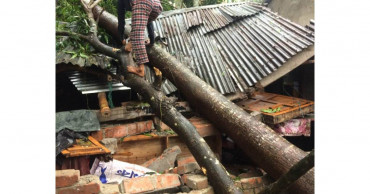damage
Cyclone Biparjoy weakens as it churns toward Pakistan after killing 2 in India and causing damage
Cyclone Biparjoy knocked out power and threw shipping containers into the sea in western India on Friday before weakening as it headed toward Pakistan, officials said.
More than 180,000 people took shelter in the two countries, but some of Pakistan's evacuees prepared to return home as the storm weakened. Indian officials said electricity had been restored in some villages, while many others were still without power.
The storm's toll was felt especially where it made landfall in India. A man and his son died when they tried to save their livestock in Gujarat state.
India, Pakistan brace for winds, flash flooding as Cyclone Biparjoy makes landfall
The storm had windspeeds of 85 kph (53 mph) and gusting up to 105 kph (65 mph) through the coastal regions of western Gujarat.
The full extent of the damage in western India wasn't immediately known. In addition to the two deaths, 23 people were injured in various areas, officials said. About 100,000 people who were evacuated in western India have been temporarily relocated to relief camps, authorities said.
The storm did other damage upon landfall, including uprooting trees and electricity poles. Officials in the coastal town of Mandvi said heavy winds threw some shipping containers into the sea at the Mundra port, one of India's largest.
India, Pakistani coasts on high alert a day before Cyclone Biparjoy is expected to make landfall
Pakistanis were especially on alert after deadly flooding last year. Wind-driven rain pelted southern coastal towns in Pakistan for a second day Friday. The cyclone was expected to cause flash floods in the country's south.
People in that region lined up to receive food donated by charities, aid agencies and local authorities.
Pakistan will decide on Saturday whether displaced people can be allowed to go back.
“The storm is expected to weaken first to a cyclonic storm and then to a depression by this evening,” a government statement said.
Shakir Din, a fisherman in the coastal town of Badin, said his family and neighbors may soon return home.
The Indian Meteorological Department said Cyclone Biporjoy set a record for the longest lifespan over the Arabian Sea, more than 10 days. Cyclone Kyarr in 2019 had a life of nine days, it said.
The Gujarat government said it deployed 184 rapid action squads to rescue wild animals and clear fallen trees in Gir National Park, home to nearly 700 Asiatic lions.
India, Pakistan deploy rescuers and plan evacuations ahead of severe cyclone
Pakistan’s Sindh province experienced one of the country's deadliest floods last summer, partly induced by climate change. At least 1,739 people were killed and 33 million were displaced.
The World Health Organization said Thursday that it was supporting Pakistan’s efforts to deal with the impact of the cyclone. Pakistan’s government and local aid groups delivered free food and drinking water to displaced people. Prime Minister Shahbaz Sharif has said his government was protecting those in the storm's path.
On Thursday, UNICEF warned that more than 625,000 children were at immediate risk in Pakistan and India.
“In Pakistan, Cyclone Biparjoy threatens a new crisis for children and families in Sindh, the province worst affected by last year’s devastating floods,” said Noala Skinner, UNICEF’s regional director for South Asia.
A 2021 study found that the frequency, duration and intensity of cyclones in the Arabian Sea increased significantly between 1982 and 2019, and experts say the increase will continue, making preparations for natural disasters more urgent.
2 years ago
European nations zoom in on establishing system to pinpoint how much damage Russia caused in Ukraine
Leaders from across Europe were wrapping a two-day summit on Wednesday, putting the final touches on a system to establish the damage Russia is causing during the war in Ukraine, in the hopes it can be forced to compensate victims and help rebuild the nation once the conflict is over.
The Russian invasion of Ukraine was the dominant topic during the meeting in the Icelandic capital, Reykjavík, where delegations from the Council of Europe discussed how the continent’s preeminent human rights organization can support Kyiv.
The most tangible outcome of the meeting — the first summit the Council of Europe has held in nearly two decades — is the creation of the register of damages. Expected to be housed in The Hague, the register will allow victims of the war to report the harm they have suffered.
Also Read: Russia's threat to exit Ukraine grain deal adds risk to global food security
“When we think in terms of reconstruction it’s an enormously important judicial element to have this register of damages to give justice to the victims,” said European Union Commission President Ursula von der Leyen said, speaking at the opening of the summit late Tuesday.
The record is “intended to constitute the first component of a future international compensation mechanism” according to a Council of Europe document. The operation will be financed by the signatories.
Such a register could be used to distribute reparations from a proposed tribunal to prosecute the crime of aggression, another concept backed by the Council of Europe. In his address to the summit on Tuesday, Ukrainian President Volodymyr Zelenskyy reiterated his country’s wish for such a court.
Also Read: G-7 leaders likely to focus on the war in Ukraine and tensions in Asia at summit in Hiroshima
There will be no reliable peace without justice,” he said, speaking to the opening session via video link.
The Council of Europe's secretary general, Marija Pejčinović Burić, announced ahead of the summit that the body intends to support the international effort to establish a judicial organ to prosecute the crime of aggression — the literal act of invading another country.
The International Criminal Court has issued an arrest warrant for Russian President Vladimir Putin and another official for war crimes, accusing him of personal responsibility for the abductions of children from Ukraine. But the court lacks the ability to prosecute aggression.
Not all of the Council of Europe’s 46 members are backing the damages register, however. Ten countries, including Hungary, Turkey and Serbia have refused to sign up. Switzerland has also not joined, but this is a result of domestic legal requirements, according to Swiss officials, and the Alpine nation plans to become a signatory as soon as possible.
2 years ago
Philippines quake causes hospital evacuation, minor damage
A strong earthquake rocked a central Philippine province on Thursday, sending people out of their homes at night, prompting dozens of patients to be evacuated from a hospital and causing minor damage to a government coliseum and business establishments, officials said.
There were no immediate reports of injuries or major damage from the magnitude 6 quake that was set off by a local fault line at a depth of 10 kilometers (6 miles), about 11 kilometers (6.8 miles) west of the coastal town of Batuan in Masbate province, officials said.
The quake struck about two hours after midnight, rousing many people from their sleep, Masbate provincial disaster-mitigation officer Adonis Dilao said.
“The first jolt was really strong followed by shaking that woke me up and my baby,” Red Cross officer MJ Oxemer told The Associated Press by telephone from the provincial capital of Masbate city. “We could hear the rumbling of the ground.”
Dozens of patients from a Masbate provincial hospital were evacuated but later brought back after the quake caused some cracks in the three-story building. A part of the ceiling on a small government coliseum in Masbate city was also damaged, Dilao said.
Cracks were also spotted in the concrete pillars of some business establishments, including grocery and drug stores in Masbate city’s downtown area, and in some houses, Dilao told The AP by telephone.
Although business owners have discretion when to reopen, Dilao said they should heed the advice of government safety inspectors because at least two strong aftershocks were felt following the quake. “Unlike typhoons, which can be predicted to give people time to brace, earthquakes can just suddenly hit,” he said.
The quake knocked out power in many areas of Masbate and nearby Ticao island, and some school classes were suspended, the Office of Civil Defense said, adding that damage assessments by local officials were underway.
The Philippines lies along the Pacific “Ring of Fire,” an arc of faults around the Pacific Ocean where most of the world’s earthquakes occur. Each year it is also hit by about 20 typhoons and tropical storms, making it one of the world’s most disaster-prone countries.
A magnitude 7.7 quake killed nearly 2,000 people in the northern Philippines in 1990.
2 years ago
Bombed, not beaten: Ukraine’s capital flips to survival mode
Residents of Ukraine’s bombed capital clutched empty bottles in search of water and crowded into cafés for power and warmth Thursday, switching defiantly into survival mode after new Russian missile strikes a day earlier plunged the city and much of the country into the dark.
In scenes hard to believe in a sophisticated city of 3 million, some Kyiv residents resorted to collecting rainwater from drainpipes, as repair teams labored to reconnect supplies.
Friends and family members exchanged messages to find out who had electricity and water back. Some had one but not the other. The previous day’s aerial onslaught on Ukraine’s power grid left many with neither.
Cafés in Kyiv that by some small miracle had both quickly became oases of comfort on Thursday.
Oleksiy Rashchupkin, a 39-year-old investment banker, awoke to find that water had been reconnected to his third-floor flat but power had not. His freezer thawed in the blackout, leaving a puddle on his floor.
So he hopped into a cab and crossed the Dnieper River from left bank to right, to a café that he’d noticed had stayed open after previous Russian strikes. Sure enough, it was serving hot drinks, hot food and the music and Wi-Fi were on.
“I’m here because there is heating, coffee and light,” he said. “Here is life.”
Kyiv Mayor Vitali Klitschko said about 70% of the Ukrainian capital was still without power on Thursday morning.
As Kyiv and other cities picked themselves up, Kherson on Thursday came under its heaviest bombardment since Ukrainian forces recaptured the southern city two weeks ago. The barrage of missiles killed four people outside a coffee shop and a woman was also killed next to her house, witnesses said, speaking to Associated Press reporters.
Read: Ukraine to civilians: Leave liberated areas before winter
In Kyiv, where cold rain fell on the remnants of previous snowfalls, the mood was grim but steely. The winter promises to be a long one. But Ukrainians say that if Russian President Vladimir Putin’s intention is to break them, he should think again.
“Nobody will compromise their will and principles just for electricity,” said Alina Dubeiko, 34. She, too, sought out the comfort of another, equally crowded, warm and lit café. Without electricity, heating and water at home, she was determined to keep up her work routine. Adapting to life shorn of its usual comforts, Dubeiko said she uses two glasses of water to wash, then catches her hair in a ponytail and is ready for her working day.
She said she’d rather be without power than live with the Russian invasion, which crossed the nine-month mark on Thursday.
“Without light or you? Without you,” she said, echoing remarks President Volodymyr Zelenskky made when Russia on Oct. 10 unleashed the first of what has now become a series of aerial attacks on key Ukrainian infrastructure.
Western leaders denounced the bombing campaign. “Strikes against civilian infrastructures are war crimes,” French President Emmanuel Macron tweeted.
Russian Defense Ministry spokesman Igor Konashenkov acknowledged Thursday that it targeted Ukrainian energy facilities. But he said they were linked to Ukraine’s military command and control system and that the aim was to disrupt flows of Ukrainian troops, weapons and ammunition to front lines. Authorities for Kyiv and the wider Kyiv region reported a total of 7 people killed and dozens of wounded.
Russian U.N. Ambassador Vassily Nebenzia said: “We are conducting strikes against infrastructure in response to the unbridled flow of weapons to Ukraine and the reckless appeals of Kyiv to defeat Russia.”
Read: Shells hit near nuclear plant; blackouts roll across Ukraine
Kremlin spokesman Dmitry Peskov also sought to shift blame for civilian hardship on Ukraine’s government.
“Ukraine’s leadership has every opportunity to bring the situation back to normal, has every opportunity to resolve the situation in such a way as to meet the demands of the Russian side and, accordingly, end all possible suffering of the civilian population,” Peskov said.
In Kyiv, people lined up at public water points to fill plastic bottles. In a strange new war-time first for her, 31-year-old Health Department employee Kateryna Luchkina resorted to collecting rainwater from a drainpipe, so she could at least wash her hands at work, which had no water. She filled two plastic bottles, waiting patiently in the rain until they had water to the brim. A colleague followed behind her, doing the same.
“We Ukrainians are so resourceful, we will think of something. We do not lose our spirit,” Luchkina said. “We work, live in the rhythm of survival or something, as much as possible. We do not lose hope that everything will be fine.”
The city mayor said on Telegram that power engineers “are doing their best ” to restore electricity. Water repair teams were making progress, too. In the early afternoon, Klitschko announced that water supplies had been restored across the capital, with the caveat that “some consumers may still experience low water pressure.”
Power, heat and water were gradually coming back elsewhere, too. In Ukraine’s southeastern Dnipropetrovsk region, the governor announced that 3,000 miners trapped underground because of power blackouts had been rescued. Regional authorities posted messages on social media updating people on the progress of repairs but also saying they needed time.
Mindful of the hardships — both now and ahead, as winter progresses — authorities are opening thousands of so-called “points of invincibility” — heated and powered spaces offering hot meals, electricity and internet connections. More than 3,700 were open across the country of Thursday morning, said a senior official in the presidential office, Kyrylo Tymoshenko.
In Kherson, hospitals without power and water are also contending with the gruesome after-effects of intensifying Russian strikes. They hit residential and commercial buildings Thursday, setting some ablaze, blowing ash skyward and shattering glass across streets. Paramedics helped the injured.
Read: Deadly missile strike adds to Ukraine war fears in Poland
Olena Zhura was carrying bread to her neighbors when a strike that destroyed half of her house wounded her husband, Victor. He writhed in pain as paramedics carried him away.
“I was shocked,” she said, welling with tears. “Then I heard (him) shouting: ’Save me, save me.”
3 years ago
15 shops gutted in Natore fire
At least 15 shops were gutted in a fire at Bangabaria Bazar in Sadar upazila of the Natore district early Sunday.
Sources said the fire broke out from an electric short-circuit at a shop of the market around 1am and it quickly engulfed the other shops.
Akhtar Hamid Khan, senior station officer of Natore Fire Service, said on information a fire fighting team from the station rushed to the spot and put out the fire with the help of locals after about an hour.
Read: Fire at Sylhet colony makes five families homeless
Some 15 shops, mostly selling garment products, medicine and shoes, were burnt in the fire, he said, adding that the extent of damage in the incident could not be fixed immediately.
3 years ago
3 dead after 7.6 quake hits Papua New Guinea
At least three people are dead after a powerful earthquake hit a remote part of Papua New Guinea Sunday morning, authorities say. Others were injured and infrastructure damaged in the magnitude 7.6 jolt that was felt across the Pacific country.
The three people died in a landslide in the gold-mining town of Wau, said Morobe Provincial Disaster Director Charley Masange. Other people had been injured from falling structures or debris, and there was damage to some health centers, homes, rural roads and highways, Masange told The Associated Press.
Masange said it could take some time to assess the full extent of the injuries and damage in the region. But he said the sparse and scattered population and lack of large buildings near the epicenter in the nation's largely undeveloped highlands may have helped prevent a bigger disaster, given the earthquake was so strong.
Read:Earthquake kills 65, triggers landslides in southwest China
One resident from the town closest to the epicenter described his ordeal to the AP.
Renagi Ravu was meeting with two colleagues at his home in Kainantu when the quake struck.
Ravu tried to stand up from his chair but couldn't maintain his balance and ended up in a kind of group hug with his colleagues, while plates and cups crashed from his shelves to the ground, he said. His children, ages 9 and 2, had their drinks and breakfast spill over.
Ravu, who is a geologist, said he tried to calm everybody as the shaking continued for more than a minute.
Ravu said that about 10,000 people live in and around his town, which is located 66 kilometers (41 miles) from the quake's epicenter.
He said people were feeling rattled.
“It's a common thing that earthquakes are felt here, but it usually doesn't last as long and is not as violent as this one,” Ravu said. “It was quite intense.”
Ravu was sorting through the damage to his home, which he said likely included a broken sewer pipe judging from the smell. He said friends elsewhere in Kainantu had messaged him with descriptions of cracked roads, broken pipes and fallen debris, but hadn't described major building collapses or injuries.
“They are starting to clean up their houses and the streets,” he said. Communication seems to have been affected, he added, with some cell towers likely to have fallen.
A magnitude 7.5 earthquake in 2018 in the nation’s central region killed at least 125 people. That quake hit areas that are remote and undeveloped, and assessments about the scale of the damage and injuries were slow to filter out.
Read: Strong undersea quake causes panic in western Indonesia
Felix Taranu, a seismologist at the Geophysical Observatory in the capital Port Moresby, said it was too early to know the full impacts of Sunday's earthquake, although its strength meant it “most likely caused considerable damage.”
According to the U.S. Geological Survey, the quake hit at 9:46 a.m. local time at a depth of 90 kilometers (56 miles). NOAA advised there was no tsunami threat for the region.
Papua New Guinea is located on the eastern half of the island of New Guinea, to the east of Indonesia and north of eastern Australia. It sits on the Pacific’s “Ring of Fire,” the arc of seismic faults around the Pacific Ocean where much of the world’s earthquakes and volcanic activity occurs.
3 years ago
Powerful earthquake shakes northern Taiwan
A powerful earthquake struck Taiwan on Monday evening, shaking buildings in the capital and across much of the northern part of the island. There were no immediate reports of serious damage or injuries.
The U.S. Geological Survey said the quake measured magnitude 6.2 and was centered at a depth of 28.7 kilometers (18 miles) below the ocean east of Hualien city on the island's east coast.
READ: 6.1 magnitude earthquake jolts Dhaka, other areas
Walls creaked as office buildings shook in Taipei, the capital. Lights swayed and mirrors and pictures fell to the floor.
The USGS said economic losses were expected to be low despite the strong shaking.
READ: Strong earthquake in southwest Pakistan kills at least 20
3 years ago
Incessant showers damage lentil, wheat & mustard crops in Narail
Incessant showers over the past three-four days have caused widespread damage to lentil, chilli, mustard and wheat crops across 18,632 hectares of farmland in Narail district, authorities said.
"The untimely rain will delay the cultivation of Rabi crops this year in the district, which starts from mid-November and lasts till March," Dipak Kumar Roy, deputy director of Narail Agricultural Extension Department, told UNB.
Also read: Faridpur flood: Over 2000ha cropland submerged for nearly four weeks
The showers have damaged winter crops like radish, cabbage, cauliflower and turnip across 1,045 hectares, mustard crops across 7,730 hectares, lentil crops across 7,545 hectares and wheat crops across 2,100 hectares, according to data.
Besides, boro seed beds across 162 hectares of farmland have also sustained damage in the rain, the Agricultural Extension Department said.
"Wheat, mustard, and lentil crops have sustained the maximum damage in the rain as these are planted across 70 percent of farmland in Narail," said Dipak. "However, the extent of damage could be ascertained only when the showers stop."
Also read: 15,520 hectares of croplands inundated in Kurigram
Tazul Islam, agricultural representative of Narail-2 MP, however, said that the district may lag in crop production this season.
4 years ago
4,000-5,000 houses damaged by cyclone ‘Bulbul’: Minister
State Minister for Disaster Management and Relief Dr Md Enamur Rahman on Sunday said some 4,000-5,000 houses were damaged by cyclonic storm ‘Bulbul’ which lashed the country’s coastal districts early Sunday.
6 years ago















